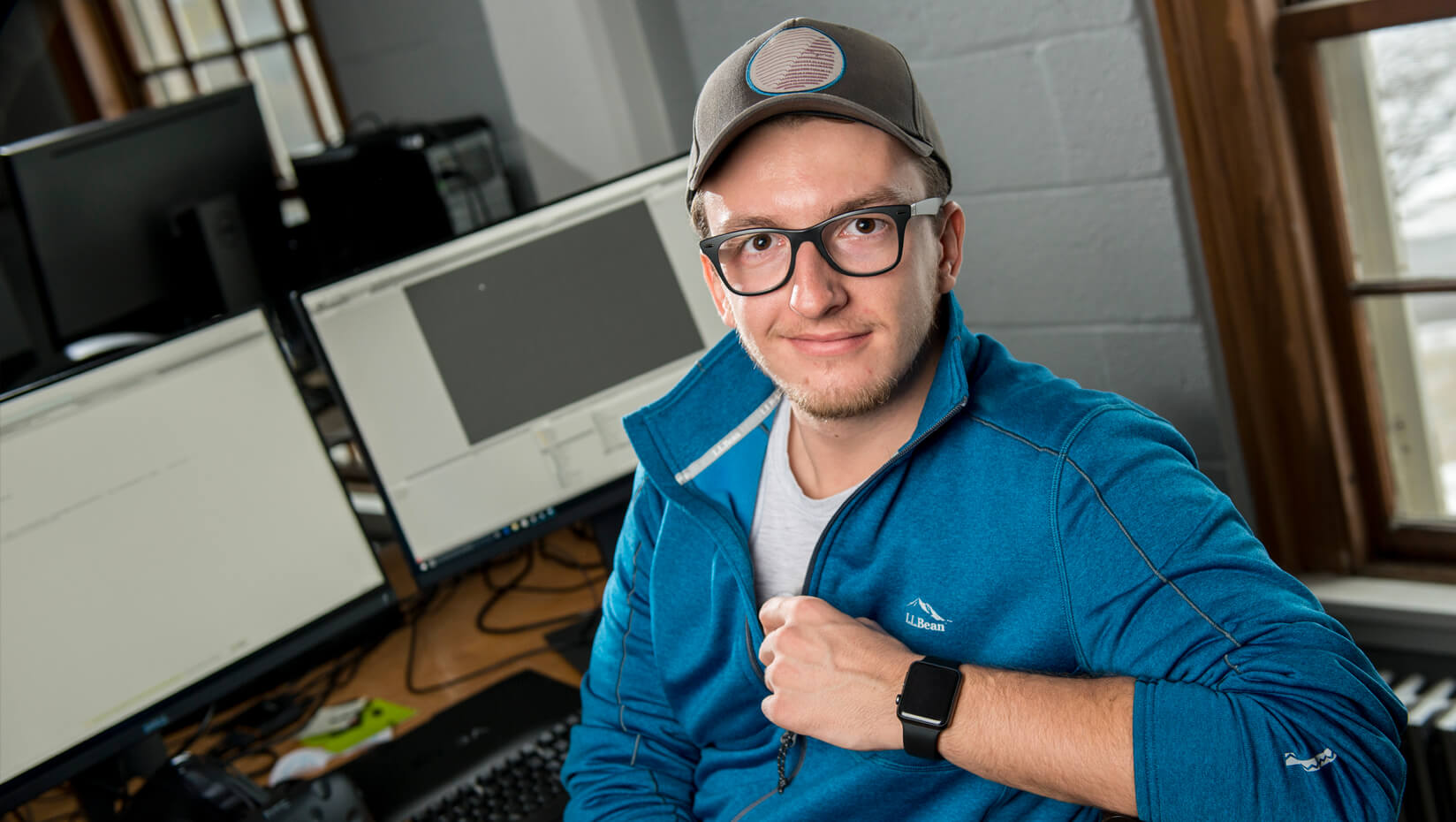
Eric Morrison: Virtual reality installation brings sea farm to life
Next month, visitors to a new exhibit at the Maine Discovery Museum in Bangor will be able to don a virtual reality headset and become immersed in a fish farm, seeing a 360-degree, panoramic, 3-D underwater world created by University of Maine new media senior Eric Morrison.
Wearing a VR headset, a visitor will be engulfed in the sights and sounds below the ocean surface. Farm-raised Atlantic salmon will whiz past in every direction and the user will be able to use robotic hands to interact with the fish.
Morrison’s project is part of “Sea What Grows Aqua Farms,” a sea farming exhibit opening at the Maine Discovery Museum in partnership with the University of Maine’s Aquaculture Research Institute, Maine EPSCoR and the Sustainable Ecological Aquaculture Network (SEANET). The exhibit opens to the public on Saturday, Feb. 4.
“One of the exhibit’s main goals is for visitors to learn about aquaculture. This exhibit is part of a growing education and outreach program that aims to increase understanding about the importance of aquaculture as a growing industry in Maine, and to increase awareness of aquaculture as a career choice,” says Anne Bowden, associate director of UMaine’s Aquaculture Research Institute.
Morrison’s contribution to the exhibit comes out of a longstanding collaboration between the museum and UMaine’s New Media Department. For the past 10 years, teams of students in an interactive design course, taught by new media instructor Mike Scott, have been given a challenge for their final class projects: come up with detailed proposals and mock ups for interactive installations that could complement museum exhibits.
“Over the years, we could almost always tell, from the original idea, if it was going to turn into a good proposal or not,” says Trudi Plummer, the Maine Discovery Museum’s director of education. Eric’s final product, she says, “was very close to the original idea.”
That original idea took shape the way most of Morrison’s new media creations do — as brainstormed sketches on a drawing pad. In one set of drawings, the York, Maine native sketched the physical exhibit space where the virtual reality experience would take place.
“What we’re trying to do is teach kids, through virtual reality, the basics of what a fish farm is — just show them this is what it looks like, in first person, to be inside the fish farm with the fish,” Morrison says.
Morrison, who is a passionate sailor, grew up on the ocean and drew on that experience as he depicted a working waterfront motif. That vision has remained largely intact. The floor in the “Sea What Grows Aqua Farms” exhibit room is painted to look like a dock. In addition, pylons rise out of the floor. There are ropes, cleats and pulleys used to harvest mussels. And there’s a mural of the open ocean, complete with the hulls of two boats sticking out of the wall.
Sketching out what the user would experience while wearing the virtual reality headset was more of a challenge. Before working on the project, Morrison knew little to nothing about sea farming.
“When you walk into the room, it’s supposed to simulate what it’s like to walk onto a real dock and have the fish farm below you. I probably spent 10 or 15 hours on the internet just researching to figure out where to start,” says Morrison, who also found out from his online research what farm-raised Atlantic salmon and the mesh-framed sea cages they live in ought to look like.
In high school, Morrison developed a passion for painting and drawing. At UMaine, he discovered that a degree in new media would allow him to satisfy his interest in art, while pursuing his other passion — technology. A major outlet for Morrison’s creativity at UMaine has been his work with ASAP Media Services, a student-run, research and development lab that undertakes projects for on- and off-campus clients.
“We make things with technology. We like to push the limits of what we’re capable of and challenge the students we’re working with,” says Morrison, who is now the lab’s student leader.
Through ASAP Media Services, Morrison has worked on other virtual reality installations, including an innovative project at Acadia National Park. Interpreters And Scientists Working On Our Parks (iSWOOP) is an organization, funded by the National Science Foundation, that works with the National Park Service to enhance visitors understanding of the science taking place in the parks. iSWOOP hired ASAP Media Services to develop a virtual reality installation that will teach visitors what 20,000 years of climate change has looked like at Acadia.
After he graduates, Morrison says he wants to work in new media, especially at a time when virtual reality in the consumer market is growing rapidly.
Contact: Jay Field, 207.581.3721; 207.338.8068
